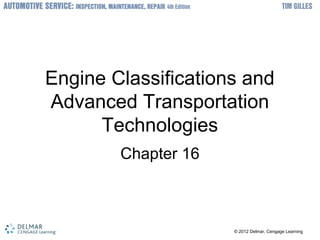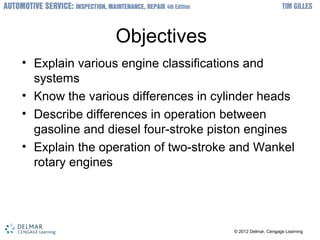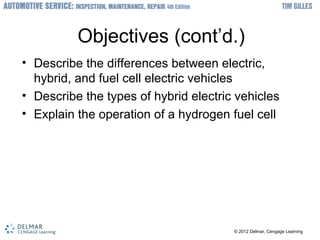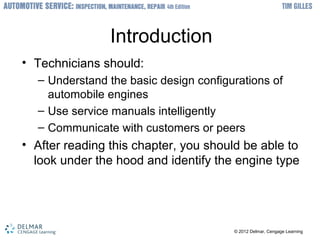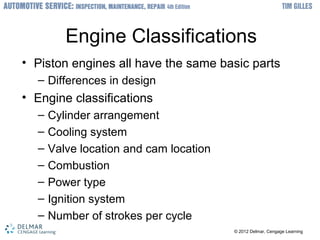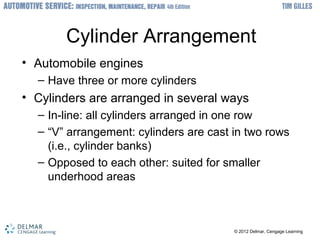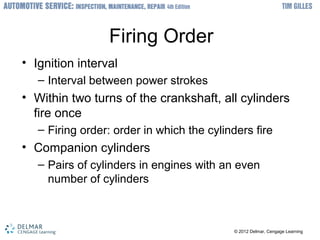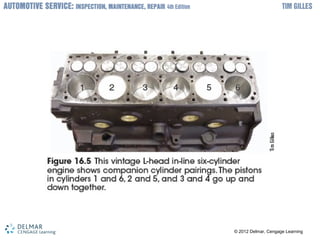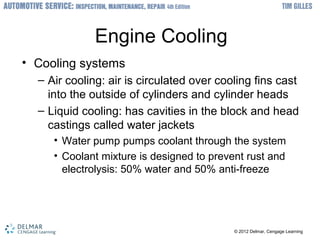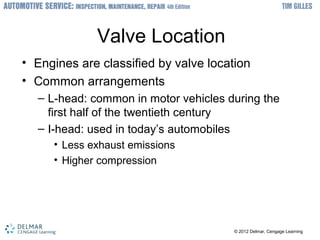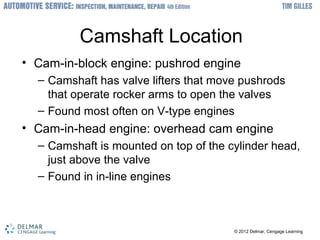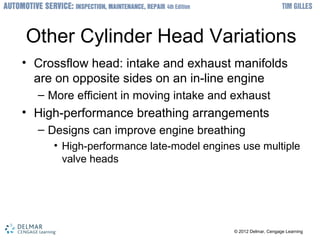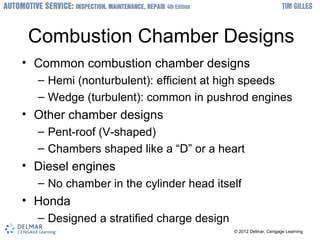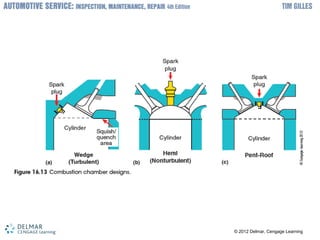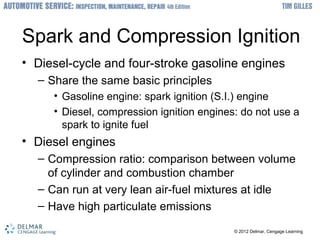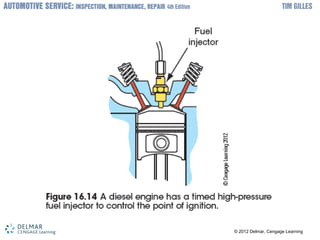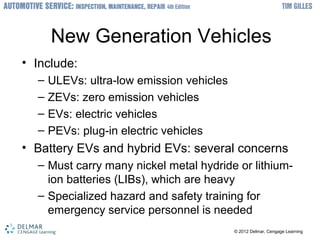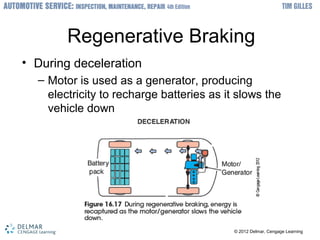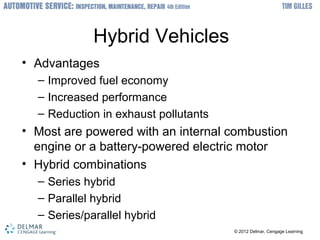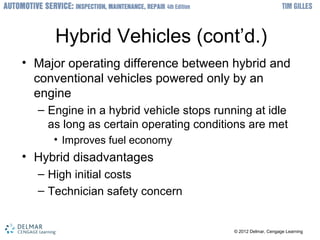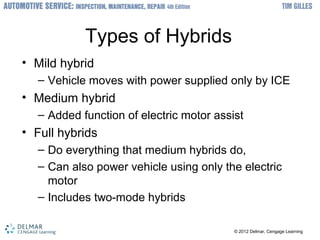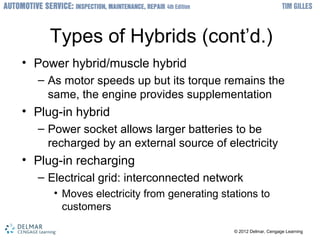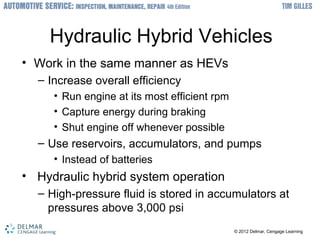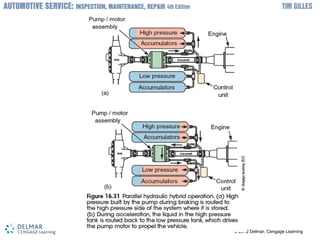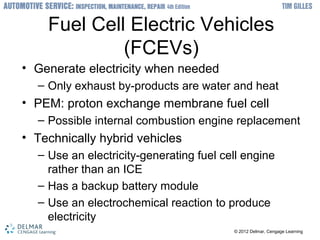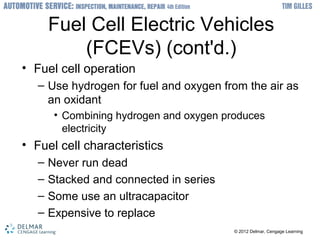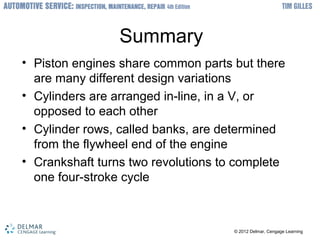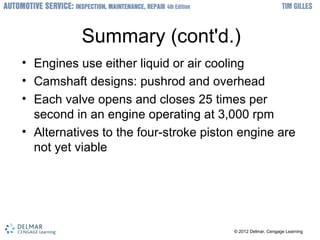1111128618 276699
- 1. ? 2012 Delmar, Cengage Learning? 2012 Delmar, Cengage Learning Engine Classifications and Advanced Transportation Technologies Chapter 16
- 2. ? 2012 Delmar, Cengage Learning? 2012 Delmar, Cengage Learning Objectives ? Explain various engine classifications and systems ? Know the various differences in cylinder heads ? Describe differences in operation between gasoline and diesel four-stroke piston engines ? Explain the operation of two-stroke and Wankel rotary engines
- 3. ? 2012 Delmar, Cengage Learning? 2012 Delmar, Cengage Learning Objectives (contĄŊd.) ? Describe the differences between electric, hybrid, and fuel cell electric vehicles ? Describe the types of hybrid electric vehicles ? Explain the operation of a hydrogen fuel cell
- 4. ? 2012 Delmar, Cengage Learning? 2012 Delmar, Cengage Learning Introduction ? Technicians should: ĻC Understand the basic design configurations of automobile engines ĻC Use service manuals intelligently ĻC Communicate with customers or peers ? After reading this chapter, you should be able to look under the hood and identify the engine type
- 5. ? 2012 Delmar, Cengage Learning? 2012 Delmar, Cengage Learning Engine Classifications ? Piston engines all have the same basic parts ĻC Differences in design ? Engine classifications ĻC Cylinder arrangement ĻC Cooling system ĻC Valve location and cam location ĻC Combustion ĻC Power type ĻC Ignition system ĻC Number of strokes per cycle
- 6. ? 2012 Delmar, Cengage Learning? 2012 Delmar, Cengage Learning Cylinder Arrangement ? Automobile engines ĻC Have three or more cylinders ? Cylinders are arranged in several ways ĻC In-line: all cylinders arranged in one row ĻC Ą°VĄą arrangement: cylinders are cast in two rows (i.e., cylinder banks) ĻC Opposed to each other: suited for smaller underhood areas
- 7. ? 2012 Delmar, Cengage Learning? 2012 Delmar, Cengage Learning
- 8. ? 2012 Delmar, Cengage Learning? 2012 Delmar, Cengage Learning Firing Order ? Ignition interval ĻC Interval between power strokes ? Within two turns of the crankshaft, all cylinders fire once ĻC Firing order: order in which the cylinders fire ? Companion cylinders ĻC Pairs of cylinders in engines with an even number of cylinders
- 9. ? 2012 Delmar, Cengage Learning? 2012 Delmar, Cengage Learning
- 10. ? 2012 Delmar, Cengage Learning? 2012 Delmar, Cengage Learning Engine Cooling ? Cooling systems ĻC Air cooling: air is circulated over cooling fins cast into the outside of cylinders and cylinder heads ĻC Liquid cooling: has cavities in the block and head castings called water jackets ? Water pump pumps coolant through the system ? Coolant mixture is designed to prevent rust and electrolysis: 50% water and 50% anti-freeze
- 11. ? 2012 Delmar, Cengage Learning? 2012 Delmar, Cengage Learning Valve Location ? Engines are classified by valve location ? Common arrangements ĻC L-head: common in motor vehicles during the first half of the twentieth century ĻC I-head: used in todayĄŊs automobiles ? Less exhaust emissions ? Higher compression
- 12. ? 2012 Delmar, Cengage Learning? 2012 Delmar, Cengage Learning Camshaft Location ? Cam-in-block engine: pushrod engine ĻC Camshaft has valve lifters that move pushrods that operate rocker arms to open the valves ĻC Found most often on V-type engines ? Cam-in-head engine: overhead cam engine ĻC Camshaft is mounted on top of the cylinder head, just above the valve ĻC Found in in-line engines
- 13. ? 2012 Delmar, Cengage Learning? 2012 Delmar, Cengage Learning Other Cylinder Head Variations ? Crossflow head: intake and exhaust manifolds are on opposite sides on an in-line engine ĻC More efficient in moving intake and exhaust ? High-performance breathing arrangements ĻC Designs can improve engine breathing ? High-performance late-model engines use multiple valve heads
- 14. ? 2012 Delmar, Cengage Learning? 2012 Delmar, Cengage Learning Combustion Chamber Designs ? Common combustion chamber designs ĻC Hemi (nonturbulent): efficient at high speeds ĻC Wedge (turbulent): common in pushrod engines ? Other chamber designs ĻC Pent-roof (V-shaped) ĻC Chambers shaped like a Ą°DĄą or a heart ? Diesel engines ĻC No chamber in the cylinder head itself ? Honda ĻC Designed a stratified charge design
- 15. ? 2012 Delmar, Cengage Learning? 2012 Delmar, Cengage Learning
- 16. ? 2012 Delmar, Cengage Learning? 2012 Delmar, Cengage Learning Spark and Compression Ignition ? Diesel-cycle and four-stroke gasoline engines ĻC Share the same basic principles ? Gasoline engine: spark ignition (S.I.) engine ? Diesel, compression ignition engines: do not use a spark to ignite fuel ? Diesel engines ĻC Compression ratio: comparison between volume of cylinder and combustion chamber ĻC Can run at very lean air-fuel mixtures at idle ĻC Have high particulate emissions
- 17. ? 2012 Delmar, Cengage Learning? 2012 Delmar, Cengage Learning
- 18. ? 2012 Delmar, Cengage Learning? 2012 Delmar, Cengage Learning Alternate Engines ? Most vehicles use internal combustion four- stroke piston engines ĻC Several other engine types have been developed ? Alternate engines found in today's vehicles: ĻC Wankel rotary (rotary engine): two rotors rotate inside of a chamber ? Do not have pistons ĻC Two-stroke cycle engines: use a mixture of oil and gasoline for lubrication of the crankshaft, connecting rod, and piston
- 19. ? 2012 Delmar, Cengage Learning? 2012 Delmar, Cengage Learning New Generation Vehicles ? Include: ĻC ULEVs: ultra-low emission vehicles ĻC ZEVs: zero emission vehicles ĻC EVs: electric vehicles ĻC PEVs: plug-in electric vehicles ? Battery EVs and hybrid EVs: several concerns ĻC Must carry many nickel metal hydride or lithium- ion batteries (LIBs), which are heavy ĻC Specialized hazard and safety training for emergency service personnel is needed
- 20. ? 2012 Delmar, Cengage Learning? 2012 Delmar, Cengage Learning Regenerative Braking ? During deceleration ĻC Motor is used as a generator, producing electricity to recharge batteries as it slows the vehicle down
- 21. ? 2012 Delmar, Cengage Learning? 2012 Delmar, Cengage Learning Hybrid Vehicles ? Advantages ĻC Improved fuel economy ĻC Increased performance ĻC Reduction in exhaust pollutants ? Most are powered with an internal combustion engine or a battery-powered electric motor ? Hybrid combinations ĻC Series hybrid ĻC Parallel hybrid ĻC Series/parallel hybrid
- 22. ? 2012 Delmar, Cengage Learning? 2012 Delmar, Cengage Learning Hybrid Vehicles (contĄŊd.) ? Major operating difference between hybrid and conventional vehicles powered only by an engine ĻC Engine in a hybrid vehicle stops running at idle as long as certain operating conditions are met ? Improves fuel economy ? Hybrid disadvantages ĻC High initial costs ĻC Technician safety concern
- 23. ? 2012 Delmar, Cengage Learning? 2012 Delmar, Cengage Learning Types of Hybrids ? Mild hybrid ĻC Vehicle moves with power supplied only by ICE ? Medium hybrid ĻC Added function of electric motor assist ? Full hybrids ĻC Do everything that medium hybrids do, ĻC Can also power vehicle using only the electric motor ĻC Includes two-mode hybrids
- 24. ? 2012 Delmar, Cengage Learning? 2012 Delmar, Cengage Learning Types of Hybrids (contĄŊd.) ? Power hybrid/muscle hybrid ĻC As motor speeds up but its torque remains the same, the engine provides supplementation ? Plug-in hybrid ĻC Power socket allows larger batteries to be recharged by an external source of electricity ? Plug-in recharging ĻC Electrical grid: interconnected network ? Moves electricity from generating stations to customers
- 25. ? 2012 Delmar, Cengage Learning? 2012 Delmar, Cengage Learning Hybrid Vehicle Service and Safety ? Considerations ĻC Electrical shock hazard ? Conduit color designations ? Other hybrid vehicle operation, safety, and service ĻC More information can be found in other chapters
- 26. ? 2012 Delmar, Cengage Learning? 2012 Delmar, Cengage Learning Hydraulic Hybrid Vehicles ? Work in the same manner as HEVs ĻC Increase overall efficiency ? Run engine at its most efficient rpm ? Capture energy during braking ? Shut engine off whenever possible ĻC Use reservoirs, accumulators, and pumps ? Instead of batteries ? Hydraulic hybrid system operation ĻC High-pressure fluid is stored in accumulators at pressures above 3,000 psi
- 27. ? 2012 Delmar, Cengage Learning? 2012 Delmar, Cengage Learning
- 28. ? 2012 Delmar, Cengage Learning? 2012 Delmar, Cengage Learning Fuel Cell Electric Vehicles (FCEVs) ? Generate electricity when needed ĻC Only exhaust by-products are water and heat ? PEM: proton exchange membrane fuel cell ĻC Possible internal combustion engine replacement ? Technically hybrid vehicles ĻC Use an electricity-generating fuel cell engine rather than an ICE ĻC Has a backup battery module ĻC Use an electrochemical reaction to produce electricity
- 29. ? 2012 Delmar, Cengage Learning? 2012 Delmar, Cengage Learning Fuel Cell Electric Vehicles (FCEVs) (cont'd.) ? Fuel cell operation ĻC Use hydrogen for fuel and oxygen from the air as an oxidant ? Combining hydrogen and oxygen produces electricity ? Fuel cell characteristics ĻC Never run dead ĻC Stacked and connected in series ĻC Some use an ultracapacitor ĻC Expensive to replace
- 30. ? 2012 Delmar, Cengage Learning? 2012 Delmar, Cengage Learning Summary ? Piston engines share common parts but there are many different design variations ? Cylinders are arranged in-line, in a V, or opposed to each other ? Cylinder rows, called banks, are determined from the flywheel end of the engine ? Crankshaft turns two revolutions to complete one four-stroke cycle
- 31. ? 2012 Delmar, Cengage Learning? 2012 Delmar, Cengage Learning Summary (cont'd.) ? Engines use either liquid or air cooling ? Camshaft designs: pushrod and overhead ? Each valve opens and closes 25 times per second in an engine operating at 3,000 rpm ? Alternatives to the four-stroke piston engine are not yet viable

